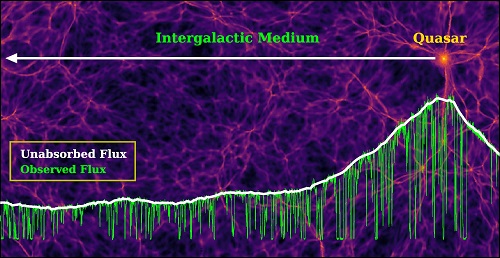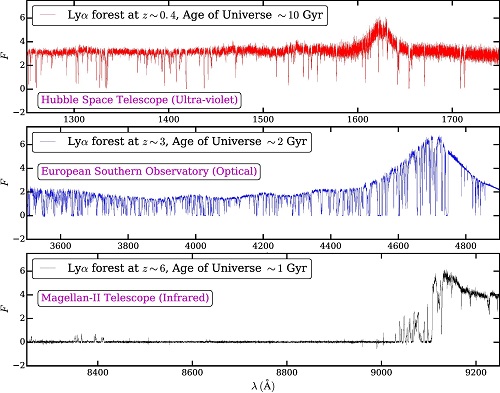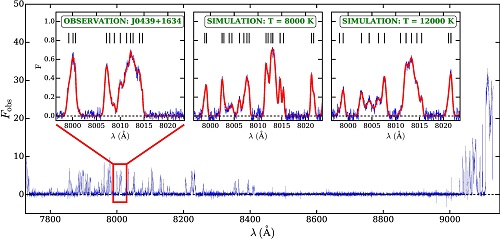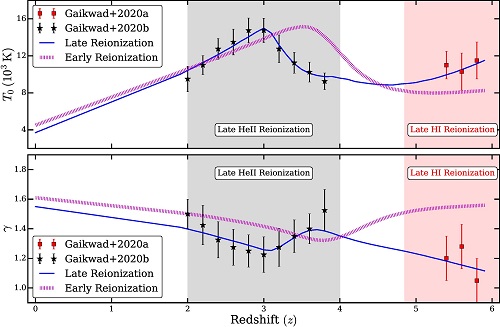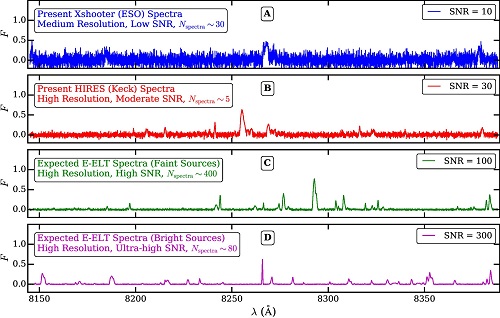Most of the baryons (e.g. H, He, C, N, O) in the Universe, at all epochs and especially at high redshift, are not contained within stars or galaxies but are in the Intergalactic Medium (IGM). The primary observational tool for deriving the physical properties (temperature, kinematics, ionization state, metal content) of these baryons is via absorption lines imprinted on the spectra of background quasars.
High-resolution quasar spectra, together with numerical simulations, have demonstrated that the IGM is arranged in a ”cosmic web” of filaments and voids, with galaxies forming in the densest regions. Figure 1 illustrates the origin of absorption features in quasar spectra due to fluctuations in the density field traced by the cosmic web. The background quasar resides in a high-density region and emits radiation over a wide range of wavelengths. Radiation at different wavelengths is absorbed by the intervening neutral gas in the IGM creating a prominent set of absorption features known as the Lyman-alpha forest.
Figure 1: The absorption features shown as the green curve are known as Lyman-alpha forest. The Lyman-alpha forest originates from variations of the neutral hydrogen density (background color image) along the line-of-sight to the quasar. The white curve shows the unabsorbed flux from the quasar as it would look if the IGM is completely ionized (no neutral hydrogen). The Lyman alpha forest contains rich information regarding the thermal, ionization, chemical and cosmological evolution of the Intergalactic Medium (see Figure 2).
Research at KICC uses quasar spectra to try and understand how the IGM evolves with time, and how galaxies and the IGM interact. Figure 2 shows the observed evolution of quasar absorption features with redshift (or equivalently age of the universe). These observations are very challenging as one needs to observe the quasars in the ultra-violet, optical and infrared wavebands using a range of telescopes such as the Hubble Space Telescope , European Southern Observatory’s VLT , as well as the Keck and the Magellan telescopes . Observations from these telescopes suggests that the amount of absorption due to neutral gas increases as we look back in time, indicating that the IGM was mostly neutral when the Universe was a bit less than ∼ 1 Gyr old. When exactly and how the IGM was ionized is one of the outstanding problems in modern cosmology.
Figure 2: The figure shows the observed Lyman-alpha forest when the Universe was 10 Gyr (top panel), 2 Gyr (middle panel) and 1 Gyr (bottom panel) old. The increase of the absorption with the age of the Universe indicates that the IGM was significantly more neutral in the distant past. When and how the IGM was ionized is one of the outstanding problems in modern cosmology. We study this “Epoch of Reionization” by modeling the Lyman-alpha forest in state-of-the-art cosmological hydrodynamical simulations (see Figure 3 and 4). The Lyman-alpha forest in the top, middle and bottom panels are observed using the Hubble Space Telescope , European Southern Observatory’s VLT and the Magellan II Telescope , respectively.
One of the areas that we focus on is the study of the processes by which hydrogen and helium in the IGM are reionized by the first galaxies and quasars, respectively. Recent projects have included determining the total mass of neutral hydrogen, charting the thermal history of the IGM, searching for the chemical signatures of the first galaxies, and measuring the total output of ionizing photons. For example, it is expected that the temperature of the IGM should increase due to the reionization of hydrogen and helium. The effect of such an increase in temperature on quasar absorption features is demonstrated in Figure 3. The absorption features in the hot IGM model (right panel) are broader than in the corresponding cold IGM model (middle panel). Thus, one can use the broadening of the absorption features to measure the temperature of the IGM.
Figure 3: An example of observed transmission spikes in quasar absorption spectra from our analysis is shown in blue at a time when the Universe was 1 Gyr old. The left panel of the inset shows an enlarged version of the red region in the observed spectrum. The middle and right panels show simulated absorption spectra from state-of-the-art high resolution cosmological hydrodynamical simulations performed using DiRAC supercomputers (Gaikwad et.al., 2020a). Note that simulated spectra and observed spectra look very similar. The middle and right panels show the effect of the IGM temperature on the broadening of the transmission spikes, the spike widths are systematically larger if the IGM is hotter. We use this effect to measure the IGM temperature by comparing the widths of the spikes from simulations with those from observations (see Figure 4).
KICC researchers working in this area exploit detailed numerical simulations comparing them with the imprint of the IGM onto the observed spectra of the most distant quasars, discovered through wide-area surveys such as VISTA and DES , and observed through the VLT and Keck high-resolution spectrometers. Figure 4 shows a summary of recent measurements of the IGM temperature by KICC researchers. The thermal state of the IGM can be described by two parameters that correlate with the properties of the ionizing sources (first galaxies and quasars). KICC researchers measure these thermal parameters by comparing the widths of absorption lines from large numbers of high-quality quasar spectra with mock spectra obtained from high dynamic range cosmological hydrodynamical simulations performed using the UK’s DiRAC supercomputers. By comparing these measurements with the theoretically expected evolution of thermal parameters, KICC researchers have shown that hydrogen and helium reionization ends later than previously thought.
KICC researchers have also shown that the high sensitivity of ELT would allow one to observe large numbers of faint sources and to reveal the very distinct last remaining transmission spikes in high-redshift quasar absorption spectra with high fidelity (see Figure 5). The unprecedented quality of ELT spectra will allow to measure reionization parameters with a few percent accuracy and to further constrain the models of reionization that are being developed at KICC.
Figure 5: Panel A and B show examples of simulated quasar absorption spectra with properties similar to those taken with ESO’s VLT and the Keck telescope. About ∼ 30 medium resolution, low SNR spectra at z ∼ 6 have been taken with the X-Shooter spectrograph on the VLT. Some high-resolution, moderate SNR spectra have been obtained with the KECK telescope, but only a few (∼ 5) probe this high redshift. With the planned HIRES spectrograph at ESO’s next-generation 40m-class ELT, the capability to observe a large number of faint sources with ultra-high resolution and ultra-high SNR will substantially increase. The spectra shown in panel C and D mimick spectra as they will be observed with ELT/HIRES. The ability to reveal the very distinct features in the spectra will allow us to measure thermal and reionization parameters (much) more precisely as is possible with the spectrographs on current telescopes.
People involved in this area are:
• Martin Haehnelt
• Prakash Gaikwad
• Richard McMahon
• Robert F. Carswell
• Vid Iršič
References
- Gaikwad P., Rauch M., Haehnelt M. G., Puchwein E., Bolton J. S., Keating L. C., Kulkarni G., Iršič V., Bañados E., Becker G. D., Boera.E, Zahedy F.S., Chen H. W., Carswell R. F., Chardin J., Rorai A. , 2020, MNRAS, 494, 5091
- Gaikwad P., Srianand R.., Haehnelt M. G., Choudhury T. R, 2020, arxiv:2009.00016
Image Credits
Dr Prakash Gaikwad


